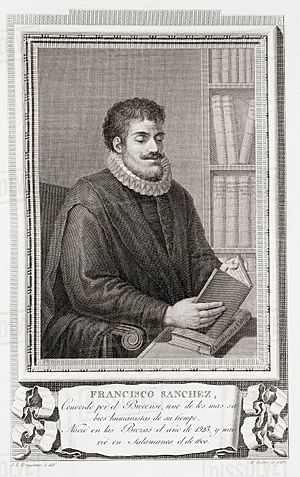Francisco Sánchez de las Brozas facts for kids

Francisco Sánchez de las Brozas (1523–1600) was a very smart Spanish scholar. People also called him El Brocense. He was an expert in languages and ancient texts. He helped change how people studied classical languages like Latin and Greek in Spain.
Contents
Life of El Brocense
Francisco Sánchez was born in Brozas, a town in Spain. His parents were from noble families but did not have much money. Francisco was able to study because his relatives helped him.
He first studied in Évora, where he learned Latin and other important subjects. Then he went to Lisbon, where he worked for Queen Catherine I and King John III of Portugal. He stayed at the Portuguese court until 1545.
After that, he went to the University of Salamanca in Spain. There, he studied Arts and Theology. While he was still a student, he got married and had six children. Later, his first wife passed away. He married again and had six more children. Supporting his large family was hard, so he had to teach constantly.
Teaching Career
In 1573, Francisco became a professor of Rhetoric at Salamanca University. Rhetoric is the art of speaking or writing effectively. In 1576, he also became a professor of Greek language. He tried twice to become a professor of Grammar, but he was not successful.
Francisco was known for his very critical mind. He believed that reason was the most important authority. This way of thinking sometimes caused problems for him.
Challenges with the Inquisition
He faced challenges from the Spanish Inquisition, which was a powerful religious court. They sometimes limited the spread of his books. In 1595, after he had retired, new problems with the Inquisition started. These issues only stopped when he died on December 5, 1600. He passed away while under house arrest by the Inquisition.
His Important Ideas
El Brocense's ideas were very important for changing how classical languages were studied in Spain. His work was as significant as that of Antonio de Nebrija, who had made similar changes earlier.
He wrote several books about language. These include Arte para saber latín (1595) and Grammaticæ Græcæ compendium (1581). He also wrote Veræ brevesque Latinæ institutiones (1587), where he improved on Nebrija's teaching methods.
The Minerva Grammar
His most famous work is Minerva sive de causis linguæ Latinæ (1587). This book was a Latin grammar divided into four parts. It looked at language using reason and logic.
The Minerva made him famous across Europe for many years. Early language experts of the Renaissance based their grammars on how ancient writers used language. But El Brocense used reason as the main idea for his grammar system. He believed only reason was truly authoritative.
He wanted everything to fit into logical patterns. He used the idea of ellipsis (when words are left out but understood) a lot in his grammar. He even thought about a universal grammar that might be hidden in all languages. His Minerva was very popular, with 15 editions printed by 1761.
Other Works
Francisco also edited and commented on works by famous ancient writers like Virgil, Ovid, Persius, and Horace. He also worked on books by Angelo Poliziano and Andrea Alciato.
He wrote comments on the works of Spanish poets like Juan de Mena and Garcilaso de la Vega. When people said he made Garcilaso seem less original by pointing out his influences from Greek and Latin writers, El Brocense replied that a good poet should imitate the classics. He also wrote many Latin poems.
He also wrote about how beautiful literature is in his books De arte dicendi (1556) and Organum dialecticum et rethoricum (1579). He even dared to criticize the writing style of the gospels, which led to problems with the Inquisition.
El Brocense was a fan of Erasmus of Rotterdam. His scientific works showed his wide range of knowledge, which was common for humanists of his time. These works include Declaración y uso del reloj español (1549) about a Spanish clock, and books about geography and the world. His philosophical works include Doctrina de Epicteto (1600) and Paradoxa (1581).
Main Works
- Declaración y uso del reloj español (1549)
- Angeli Politiani: Sylvæ, nutricia, manto, rusticus, ambra illustratum per Franciscum Sanctium Brocensem (1554)
- De arte dicendi (1556)
- Comment. in And. Alciati Emblemata (1573)
- Comentarios to the work by Garcilaso de la Vega (1574)
- Pomponii Melæ De situ orbis (1574)
- Organum dialectum et rethoricum cunctis discipulis utilissimum et necessarium (1579)
- Sphera mundi ex variis auctoribus concinnata (1579)
- Paradoxa (1581)
- Grammaticæ Græcæ compendium (1581)
- Comentarios to the work by Juan de Mena (1582)
- Minerva sive de causis linguæ Latinæ (1587)
- Veræ brevesque Latinæ institutiones (1587)
- De nonnulis Porphyrii aliorumque in dialectica erroribus (1588)
- Edition of the Bucolics by Virgil (1591)
- In Artem Poeticam Horatii Annotationes (1591)
- Arte para saber latín (1595)
- Doctrina de Epicteto (1600)
See also


